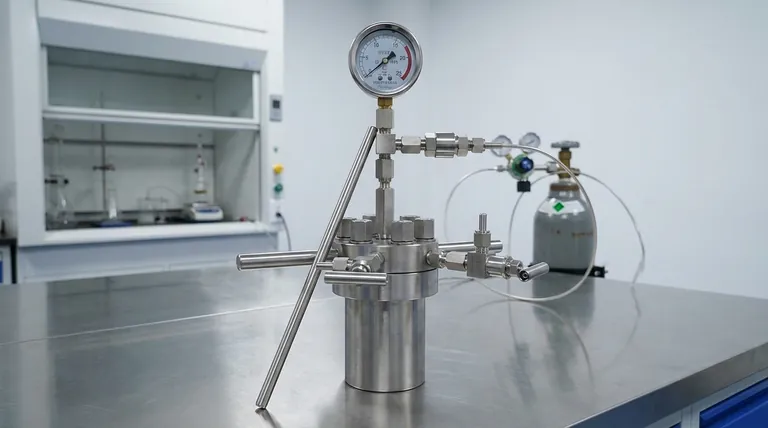In most applications, a pyrolysis reactor operates at or slightly above atmospheric pressure. The process is fundamentally a low-pressure thermal decomposition, where the internal pressure is a result of the gases produced during heating, not a condition that is actively applied.
The critical insight is that pressure in a standard pyrolysis reactor is not a primary input but a consequence of the process itself. It is managed near atmospheric levels to maintain an oxygen-free environment safely and cost-effectively, directly influencing product yield and quality.

The Role of Pressure in Pyrolysis
Pyrolysis is the thermal decomposition of materials at elevated temperatures in an oxygen-free environment. Understanding the pressure dynamics within the reactor is key to controlling the process.
Pressure is a Result, Not an Input
In a typical pyrolysis system, the reactor is sealed to prevent oxygen from entering, which would cause combustion. As the feedstock heats up and decomposes, it releases a mixture of non-condensable gases (syngas) and condensable vapors (which become bio-oil).
This generation of gas and vapor naturally increases the pressure inside the sealed vessel. The primary goal is not to achieve high pressure, but to manage this self-generated pressure.
Operating Near Atmospheric Pressure
Most pyrolysis reactors are designed to operate at pressures slightly above atmospheric (e.g., 1-5 bar gauge). This slight positive pressure is highly desirable because it ensures that if any minor leaks occur, the pyrolysis gases will leak out rather than air leaking in.
Preventing air ingress is the single most important safety and process consideration to avoid unwanted oxidation or explosive conditions.
How Reactor Type Influences Pressure Strategy
While near-atmospheric pressure is the norm, specific process goals can lead to specialized pressure conditions.
Standard Slow and Fast Pyrolysis
For the most common types of pyrolysis, which aim to produce either biochar (slow) or bio-oil (fast), the reactor is operated at low pressure. This condition is optimal for balancing equipment cost, operational safety, and desired product formation.
Vacuum Pyrolysis
This is a specialized variant where the reactor is operated under a vacuum (below atmospheric pressure). The lower pressure reduces the boiling point of the decomposition products.
This allows vapors to be removed from the hot reaction zone very quickly, minimizing secondary reactions like thermal cracking. The result is often a higher yield and quality of bio-oil.
Hydropyrolysis and High-Pressure Systems
In rare and specialized applications like hydropyrolysis, high pressures (30 to 350 bar) are used. However, this process involves adding hydrogen gas to the reactor to chemically stabilize the products.
This is fundamentally different from conventional pyrolysis and is more akin to a high-pressure hydrogenation process. It is not representative of typical biomass or waste pyrolysis systems.
Understanding the Trade-offs
Choosing an operating pressure involves balancing competing factors of safety, cost, and product outcome.
The Risk of Air Ingress
Operating exactly at or below atmospheric pressure (without a full vacuum system) creates a constant risk. Any fault in the reactor seals could draw in oxygen, compromising the product and creating a significant safety hazard. This is why a slight positive pressure is the industry standard.
The Complications of High Pressure
Intentionally designing for high pressure dramatically increases costs. It requires thicker reactor walls, more complex and expensive seals, and more stringent safety protocols. Furthermore, higher pressures can promote secondary gas-phase reactions, which can decrease the yield of desired liquid bio-oil in favor of more gas.
The Challenge of Vacuum Systems
While vacuum pyrolysis can improve bio-oil quality, it adds complexity. The system requires robust vacuum pumps and exceptionally reliable seals to maintain sub-atmospheric pressure and prevent leaks, which increases both capital and operational costs.
Matching Pressure Strategy to Your Objective
The ideal pressure is determined by your end goal. Use this as your guide.
- If your primary focus is maximum operational simplicity and safety: A system designed to run at a slight positive pressure (1-2 bar) is the most reliable and cost-effective choice.
- If your primary focus is maximizing liquid bio-oil yield: Consider fast pyrolysis at near-atmospheric pressure or, for higher quality, a more complex vacuum pyrolysis system.
- If your primary focus is producing syngas: Higher temperatures are more important than pressure, though moderate pressures can sometimes be used to influence gas composition.
Ultimately, controlling pressure is about controlling the reactor environment to achieve a specific, desired outcome.
Summary Table:
| Pressure Condition | Typical Use Case | Key Characteristics |
|---|---|---|
| Slight Positive Pressure (1-5 bar) | Standard Slow & Fast Pyrolysis | Industry standard for safety, prevents air ingress, cost-effective. |
| Vacuum (Below Atmospheric) | Specialized Bio-Oil Production | Improves bio-oil yield/quality by removing vapors quickly; higher cost. |
| High Pressure (30-350 bar) | Hydropyrolysis (with Hydrogen) | Rare, specialized process for product stabilization; not typical. |
Ready to optimize your pyrolysis process? The right reactor pressure is critical for safety, efficiency, and product yield. KINTEK specializes in lab-scale pyrolysis equipment and consumables, helping you achieve precise control for your research and development goals. Contact our experts today to discuss how we can support your laboratory's specific needs.
Visual Guide

Related Products
- Customizable High Pressure Reactors for Advanced Scientific and Industrial Applications
- Electric Rotary Kiln Small Rotary Furnace Biomass Pyrolysis Plant
- Stainless High Pressure Autoclave Reactor Laboratory Pressure Reactor
- Mini SS High Pressure Autoclave Reactor for Laboratory Use
- High Pressure Laboratory Autoclave Reactor for Hydrothermal Synthesis
People Also Ask
- What are autoclaves used in the chemical industry? High-Pressure Reactors for Synthesis & Curing
- How high pressure is created in a lab? Master Safe and Precise Pressure Generation
- What is the temperature range of a stainless steel reactor? Understand the Real-World Limits for Your Process
- How is high pressure generated in an autoclave? Unlock the Science of Sterilization & Synthesis
- What are the advantages of a chemical reactor? Unlock Precision, Efficiency, and Safety in Your Process



















